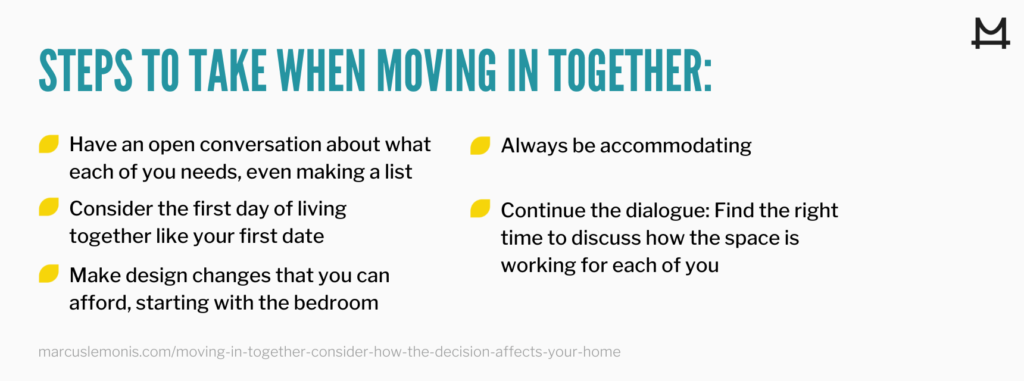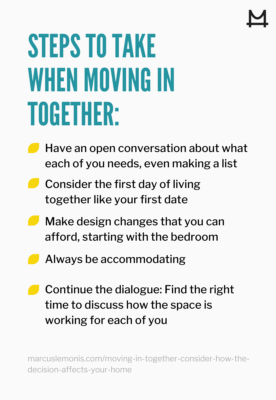Making the decision to move in together is exciting but also creates new challenges for a home. Cohabitation may be a prelude to marriage, a way to split rent, or a fling that has taken a serious turn—until you’ve moved in together! Whatever the case, there are many things to consider, especially when one person is leaving their home to move into the other person’s space.
In fact, that’s where it gets tricky. To make the home function well for both people, sacrifices will need to be made. It’s important to think this through because while times have changed, there isn’t a lot of information out there about adapting lifestyles when cohabitating.

A Test of Perspectives
When I was a child, in the late 1970s and 1980s, it was far more of a taboo for people to live together if they weren’t married. You had to do it in secret. People would say, “You’re living in sin!” Today, more people live together whether they’re married or not. You see kids in college moving in together; you see young couples moving in together and they’re not married, and one person may own the home and the other may not.
It’s a very slippery slope when people move in together, because you’re bringing two cultures, two upbringings, two styles, and two levels of preferences.
Like, “I eat this way, and you eat that way. I like to fold the clothes this way, and you fold the clothes that way. I like to organize my pantry this way.” And the list goes on and on.
I have had multiple situations where I lived with somebody. And in one case, the relationship ended because I couldn’t coexist with them. Not as a human being. I liked them very much as a person, but I couldn’t live with them. Because their style of living, and the way they saw the space was too different from mine. I tried to modify my behavior, they tried to modify their behavior. And in the end, it didn’t work.
In my relationship that I’m in today, in my marriage, I had learned from my previous mistake. And we had a lot of open dialogue before we moved in together about funny little nuance things. Like, “I need you to know, this is the kind of person I am. My closet has to be right. I need my pantry to be right. I don’t like expired foods in the fridge. I like the house to be cleaned every day. I don’t like to see laundry in the laundry basket for more than a day. I like my bed to be made a certain way.”
I wanted to put it all out there. And then we did something that I think is applicable to any couple moving in together. We got on the same page, literally.



Making a List, Making Changes
I said, “This is my list; what’s on your list?” And she gave me her list. She said things like, “I don’t want to fold my laundry that way” and “I don’t want to have to live like I’m living in a museum.”
We figured out when we made our lists that there was some common ground. Yes, there were certain things I had to give in on. There were certain things she had to give in on. But once we came up with that list, the reality of her moving in became very present.
I had lived in this home with somebody else. I wanted this new relationship to work at all costs. I was unbelievably anxious about how to create a clean new space for the new member of the household.
I made a decision. The first room we would change would be the one where we would sleep eight hours per night, where we would spend arguably more time than anywhere else: the bedroom. It had to be a clean slate—new bed and bedding, new furniture, new wallpaper and carpeting. I needed it to be totally different from anything that she had seen before, and I made her party to the change.
She kept saying to me, “I’m cool, I’m good,” and I said, “I’m not; we’re going to start in the bedroom, because it’s our space.”
I would encourage homeowners to do something similar if their significant other is moving in with them. Establish where you have common ground and where you’ll each need to compromise. And for the homeowner, make whatever changes you can afford in order to make your significant other feel, right out of the gate, that this is their home too. Start with the bedroom, and if your budget allows, you can move to the kitchen, or you could move into another space that’s important to the person moving in.

The Rules of Accommodation
The giddy feeling and the anxiety that you have when you’re going to go on a date for the first time with somebody is the same giddy feeling that I want you to have when somebody’s going to move in with you.
That feeling is founded in one principle: You’ll do anything or say anything to get a yes. Because you’re excited and you’re romantic, you’re feeling like you can accommodate anything. For instance, when you’ve had that first date and you’re trying to get a second date, you’re the most accommodating person in the world.
If your date says, “I’d like you to pick me up at 5:42, and I want you to wear blue shoes and a brown belt,” oddly enough, you show up at 5:42 with blue shoes and a brown belt. However, five years later, when you get that same request, you won’t do it.
Your willingness to acquiesce, to accommodate, on the first date is the same as you should be willing to do on the first night that you’re going to live together. That same excitement, that same anxiety, that same accommodation, that same willingness to acquiesce should exist.
Going forward, it’s important to have honest conversations about each other’s needs in relation to your home. The first one is the hardest but the most impactful, because you can level-set before or as soon as you start sharing a space.
Be sure to pick the right time to have that initial talk—don’t do it at 6 p.m. on Tuesday night after both of you have gotten home from work and it’s been a long day.

Picking the moment to have that conversation is as important as the conversation itself. Try a Saturday afternoon when you’re taking a walk, or pick a Sunday night when you’re having dinner.
At first and forever after, be thoughtful about when you bring up controversial topics about your home and about your space. Because the receiver has to be willing and able to receive whatever message you’re going to deliver. And the home is a controversial topic.
Know your audience and know your timing. The greatest comedians in the world are great not only because their jokes are good, but because they know how to land them at the right time.




